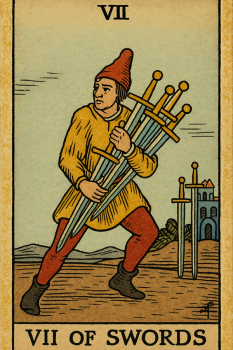
The Evolution of Tarot Symbolism: From Medieval Allegories to Today
Why Tarot Imagery Matters
Tarot isn’t just a deck of cards — it’s a visual language that’s evolved over centuries. Each image is a portal to collective myth, psychology, and personal intuition. When you trace the transformation of tarot symbolism, you’re also tracing how humanity’s ideas about destiny, the soul, and the mysteries of life have shifted.
Early Tarot: Game, Not Oracle
The earliest known tarot cards come from 15th-century Italy, where decks like the Visconti-Sforza were lavish hand-painted creations for noble families. These decks were primarily used for a card game called trionfi (triumphs), not divination.
Their imagery was rich in medieval and Renaissance allegories — virtues, classical figures, and Christian morality tales. For instance:
- The Pope (Hierophant) reflected ecclesiastical power.
- The Emperor & Empress showcased worldly rule.
- The Wheel of Fortune reminded players of life’s unpredictability.
These symbols were cultural reflections, meant to amuse and moralize, not explicitly occult.
Occult Reimagining: Etteilla & Lévi
It wasn’t until the 18th century that tarot shifted from parlor amusement to mystical tool. French occultist Jean-Baptiste Alliette (Etteilla) published the first tarot deck explicitly for divination, reshaping card meanings into esoteric messages.
Later, Eliphas Lévi, a former Catholic seminarian turned occultist, added new dimensions. He tied tarot to the Hebrew alphabet, the Tree of Life in Qabalah, and ancient Egyptian mysteries (though historically inaccurate). Lévi wrote:
“The Tarot, if correctly understood, is a work of the highest science, the science of sciences.”
Though his Egyptian claims were romantic fantasy — no tarot existed in ancient Egypt — his ideas deeply shaped Western esotericism.
The Rider-Waite-Smith Revolution
In 1909, Arthur Edward Waite, a mystic and member of the Golden Dawn, collaborated with artist Pamela Colman Smith to create what we now call the Rider-Waite Tarot. This was the first popular deck to illustrate all 78 cards with full scenes, not just the Majors.
Smith’s art was revolutionary:
- The Minor Arcana gained storylike images, turning abstract suits into living archetypes.
- Her subtle inclusion of alchemical, astrological, and Christian mysticism brought multi-layered meanings.
It made tarot accessible and intuitive, setting the standard for most modern decks.
Crowley & The Thoth Tarot: A New Aeon of Symbols
Meanwhile, Aleister Crowley — occultist, poet, and founder of Thelema — envisioned tarot as a reflection of his doctrine of a New Aeon. He commissioned Lady Frieda Harris to paint the Thoth Tarot in the late 1930s.
Crowley’s symbolic shifts were profound:
- He renamed cards to emphasize Thelemic ideas: e.g., Strength became Lust, and Judgment became The Aeon.
- The Thoth deck integrated astrological glyphs, Enochian magic, Qabalistic paths, and Crowley’s vision of cosmic evolution.
It was less about moral lessons, more about ecstatic transformation and aligning with True Will.
Egyptian & Hermetic Influences: Myth vs. Mystery
So what about Egypt? Many 19th-century occultists (like Lévi and later Paul Foster Case) claimed tarot originated in Egyptian mystery schools. No direct evidence supports this. The myth persisted partly because:
- Hermeticism (which inspired much of Western magic) revered Egypt as the land of Thoth, god of wisdom.
- The Book of Thoth was a legendary text of ultimate arcane knowledge.
Crowley named his deck after this mythic book, further entwining tarot with Egyptian mystique.
Modern Tarot: A Canvas for New Symbolism
Today’s tarot decks draw on everything from feminist archetypes to cosmic sci-fi. Yet they still inherit DNA from:
- The medieval allegories of the Visconti decks
- Lévi’s Qabalistic frameworks
- Waite & Smith’s psychological narratives
- Crowley’s ecstatic mysticism
When you shuffle your cards, you’re holding centuries of evolving human attempts to grasp fate, meaning, and mystery.
Related Articles
The Oldest Tarot Decks: From Renaissance Luxury to Modern Magic
Discover the oldest tarot decks, from the lavish Visconti-Sforza cards of 15th-century Italy to the Tarot de Marseille. Explore how these Renaissance luxuries evolved into powerful tools for modern witches.
Learn Tarot Easily with the LVX Tarot Tutor
Discover how you can learn tarot easily through the LVX Tarot Tutor — a conversational guide trained by LVX in the ancient wisdom of the cards. Explore how our carefully trained intelligence brings tarot symbolism, insight, and guidance to life.
What is the Rider Waite Tarot Deck? Origins, Symbolism & How to Read It
What is the Rider Waite Tarot deck? Discover its fascinating origins, rich symbolism, and how to use this iconic deck to unlock your intuition and personal growth.